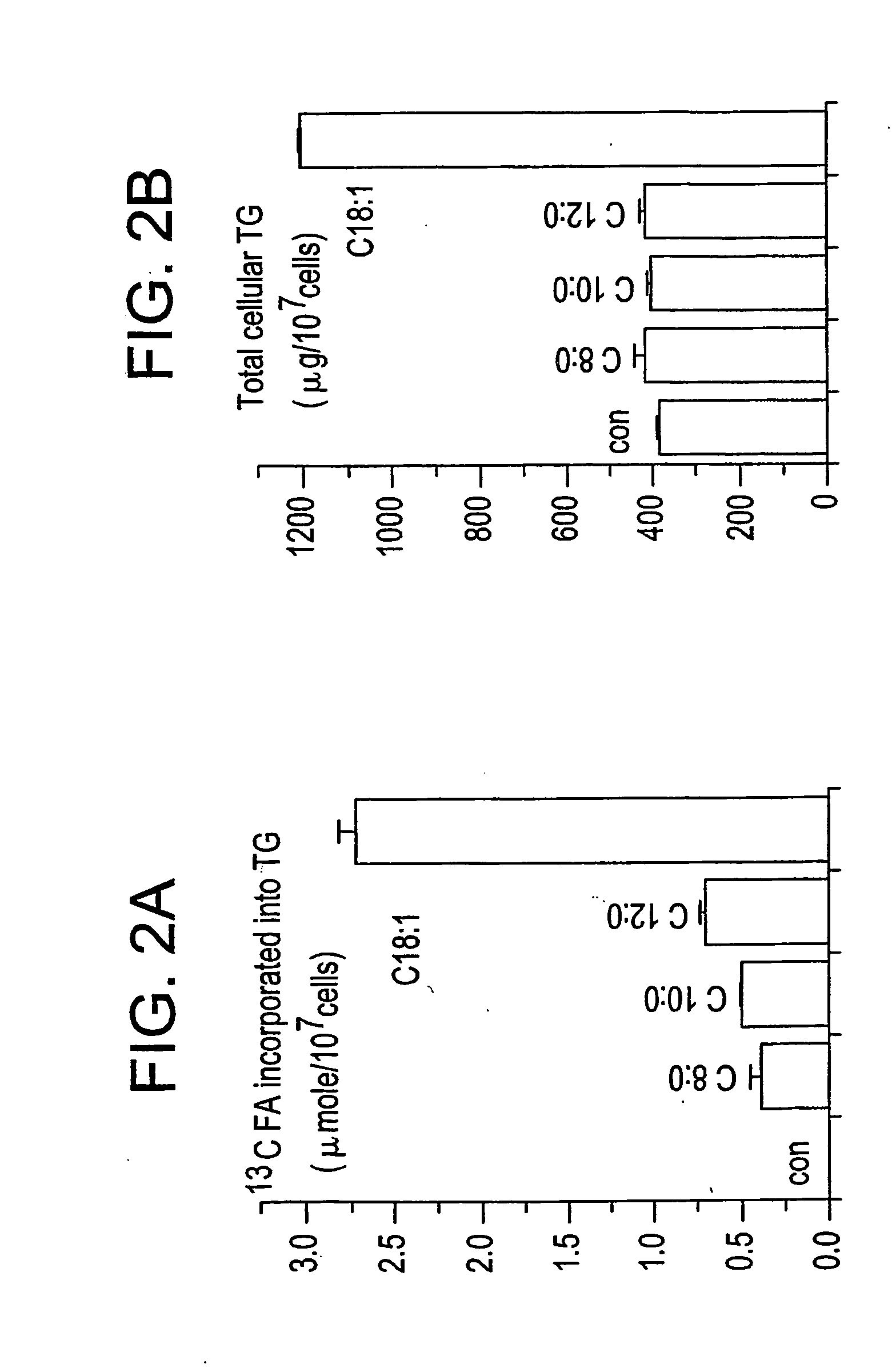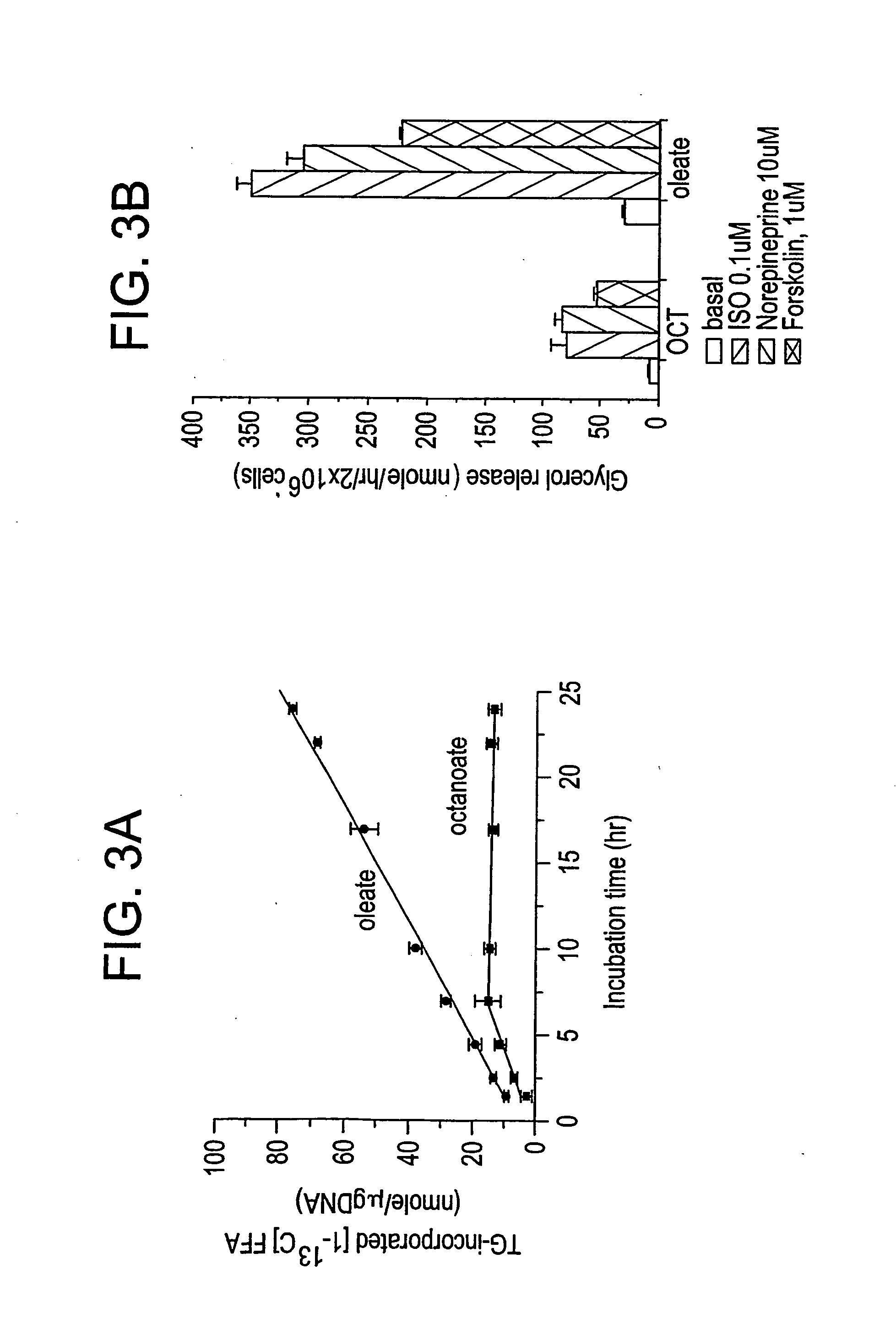Modified-fat nutritional products useful preventing or treating obesity
- Summary
- Abstract
- Description
- Claims
- Application Information
AI Technical Summary
Benefits of technology
Problems solved by technology
Method used
Image
Examples
example 1
Both Octanoate and Oleate are Actively Metabolized by Fat Cells, However, Octanoate is More Oxidized than Stored
[0082] The partitioning of exogenous octanoate and oleate into the metabolic end products of CO2 and TG is shown in Table 2. Incorporation of either octanoate- or oleate-derived 14C isotopes into other lipid fractions (cholesterol, phospholipids and diglycerides) was much less extensive (results not shown). The data show that under identical culture conditions, octanoate partitioned into CO2 more extensively than TG, but the opposite was found for oleate. The total number of mol of exogenous fatty acids converted into TG plus CO2 within 60 min was similar. Considering that each octanoyl chain only produces 8 CO2 molecules (eight times values in Table 2) whereas oleate produces 18 CO2 molecules (18 times value in Table 2), the actual the amount of CO2 produced from octanoate was about 3-fold greater than that from exogenous oleate.
TABLE 2Exogenous octanoate and oleate in...
example 2
Both Octanoate and Oleate are Direct Incorporated by Fat Cells into Cellular Lipids
[0085] The 13C-NMR spectra of lipid extracts from 3T3-L1 adipocytes incubated with [1-13C]octanoate or [1-13C]oleate for 24 hare shown in FIGS. 1(A) and 1(B). For comparison, a spectrum of the lipid extract from HepG2 cells incubated with [1-13C]octanoate for 24 h is shown in FIG. 1(C). The carbonyl signals are shown in the left-hand panels and aliphatic carbon signals in the right-hand panels. Spectra obtained under other incubation conditions had similar general features with different peak intensities.
[0086] [1-13C]oleate and [1-13C]octanoate were each found to be esterified to TG at the sn-1,3 as well as the sn-2 positions in fat cells (FIG. 1), represented by the peaks arising from the corresponding carbonyl resonances, TG(1,3) and TG(2). Such direct esterification of [1-13C]octanoate was not detected in HepG2 cells (FIG. 1C), whereas [1-13C]oleate was directly esterified in HepG2 cells [30] to...
example 3
Acetyl-CoA Derived from the β-Oxidation of Octanoate can be Utilized for de Novo Fatty Acid Synthesis and then Stored in Cellular Triglyceride
[0087] In principle, the acetyl-CoA derived from the β-oxidation of [1-13C]FFA can be used for de novo FFA synthesis. Any incorporation of [1-13C]acetyl-CoA into the acyl methylene would be detected by NMR. In previous studies on fat cells treated with oleate or palmitate, partitioning of exogenous fatty acids into this pathway was not detected [25,27,31]. However, for cells incubated with octanoate, it was found that the integrated intensities of some methylene peaks representing a single carbon (α+1, α−1, etc.) were about 2-fold more intense than the ωCH3 peak (FIGS. 1B and 1C), indicating selective labelling of the aliphatic region with 13C isotope. Peaks for the αCH2 and (α+1)CH2 generally were broader or split because of the magnetic shielding from sn-1,3 or sn-2 carbonyls. Therefore, the peak heights of these signals were lower than the...
PUM
 Login to View More
Login to View More Abstract
Description
Claims
Application Information
 Login to View More
Login to View More - R&D
- Intellectual Property
- Life Sciences
- Materials
- Tech Scout
- Unparalleled Data Quality
- Higher Quality Content
- 60% Fewer Hallucinations
Browse by: Latest US Patents, China's latest patents, Technical Efficacy Thesaurus, Application Domain, Technology Topic, Popular Technical Reports.
© 2025 PatSnap. All rights reserved.Legal|Privacy policy|Modern Slavery Act Transparency Statement|Sitemap|About US| Contact US: help@patsnap.com



